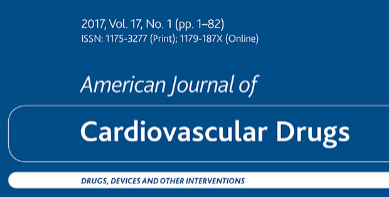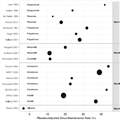Abstract and Introduction
Abstract
A number of therapeutic strategies exist for the restoration and maintenance of sinus rhythm in patients presenting with atrial fibrillation. The acute success rate with electrical cardioversion is high. However, many patients relapse into atrial fibrillation. A major challenge faced by those who care for patients with atrial fibrillation is the long-term maintenance of sinus rhythm whilst avoiding treatment-related adverse effects. This review examines the efficacy and tolerability of conventional anti-arrhythmic drugs for the secondary prevention of atrial fibrillation in the post-cardioversion period.
1 Introduction
Atrial fibrillation (AF) is the most common clinically encountered arrhythmia. It is associated with an increased mortality, risk of stroke, and often causes symptoms such as palpitations, dyspnea, and fatigue. In the long term, restoring and maintaining sinus rhythm carries no prognostic advantage over a simple strategy of mitigating the dangers of AF by anticoagulation and rate control. However, maintaining sinus rhythm does confer a benefit in reducing symptoms and enhancing functional capacity in a substantial proportion of patients.
The task of restoring and maintaining sinus rhythm was until recently accomplished using anti-arrhythmic drugs (AADs) and electrical cardioversion (ECV) or was not achieved.[1] In the past 15 years, ablation and surgery have played an increasing role in preventing recurrences of AF, but they are not universally applicable or inevitably successful.[2] ECV remains a common procedure and AADs an important adjunct to it.[3]
With optimal technique and waveform, ECV is almost always effective, but AF usually recurs.[4–7] In part, this reflects the persistence of the factors that provoked AF in the first instance; in part, it is due to secondary AF-induced alterations to the atrial myocardium.[8,9] These abnormalities resolve slowly after the restoration of sinus rhythm, so cardioversion may be considered an incomplete treatment unless steps are taken to maintain sinus rhythm for a period of months afterwards. Therefore, ECV should not be considered curative and the key factor guiding the decision to electively perform the procedure is the likelihood of maintaining sinus rhythm in the long term. Without adjunctive pharmacological therapy, 69–84 % of patients experience recurrence of AF.[10] The majority of recurrences of AF following ECV occur within the first few months, with a peak incidence in the first 5 days.[11–13] Van Gelder et al.[13] describe a useful time-dependent classification of relapses of AF following restoration of sinus rhythm: no conversion, acute recurrence (before discharge), subacute recurrence (<2 weeks), and late recurrence (>2 weeks). Such timeframes are important when considering the relative efficacy of interventions.
When evaluating the clinical utility of rhythm control strategies, a number of parameters should be considered: efficacy, safety, tolerability, and cost. Evaluation of these variables in AF trials is challenging. Pharmacological AF trials use differing definitions, timeframes, and levels of rigour to evaluate recurrence, making comparisons between trials difficult. Dosing is variable and levels of cross-over are often high. Participants are often heterogenous between and within studies, having markedly differing underlying etiologies, substrates, and prior durations of AF. AF is a progressive condition, and we now understand a number of mechanisms to contribute to the genesis and propagation of AF, better appreciating the profound impact of continued fibrillation on the electrical and structural milieu. This has significant practical implications for the management of AF as even the most effective agent, amiodarone, loses its efficacy in treating advanced fibrillatory disease.[14] The paradigm of early effective intervention to halt the progression of fibrillation-related remodeling may well in the future be considered as self-evident as it is with disease-modifying antirheumatic drugs and chemotherapy in other disciplines.
Many older trials did not adequately report mortality, which is concerning when placed in the context of the knowledge that AF and anti-arrhythmic therapy themselves are associated with increased mortality: in patients with AF, 5 % per patient-year for those receiving AADs versus 2 % per patient-year for those not receiving AADs.[15] With some praiseworthy exceptions, very few trials report on the incidence of stroke and heart failure, which are key sequelae of the disease.
Amongst trials, the guidance to discontinue agents based on adverse effects is variable and categorization of what constitutes a treatment-related adverse event is often difficult. Treatment failures and adverse events, and therefore discontinuation rates, accrue year by year. Efficacy and tolerability profiles are hence very sensitive to interval censoring and duration of follow-up. The vast majority of trials examining the efficacy of secondary prevention agents following ECV do not extend beyond 18 months; however, AF is a chronic disease and it is the long-term utility of agents that concerns patients and clinicians. For longer-term data we must turn to the data from the influential rate versus rhythm trials, STAF, AFFIRM, and RACE, which were not primarily designed to assess the secondary preventative effect of AADs following ECV.[4,16,17] The finding of equivalence between rate and rhythm control strategies is not all that surprising when one considers that pharmacological rhythm control only maintains sinus rhythm in 23–60 % of recipients over 2–5 years of therapy. Such patients should not be considered to have been randomized to sinus rhythm but rather to a group of therapies with at best moderate efficacy and at worst associated with increased rates of adverse events that offset any modest gains. On-treatment analysis has demonstrated an almost 50 % increase in mortality with AAD therapy.[18] Those who do remain in sinus rhythm often fare better in terms of mortality and morbidity than their counterparts who remain in AF; however, it is unclear whether sinus rhythm is a determinant or simply a marker for the absence of other adverse factors.[17,19] In clinical practice, even over the medium-term time horizon, it can be seen that rates of continuation of commonly used agents, such as amiodarone, flecainide, and sotalol, halve every few years.[20]
Whilst direct costs associated with therapy are relatively straightforward to calculate, indirect treatment-related costs are high but nebulous, especially over projected timelines. The external validity of trial results in key affected populations is often limited, as those with multiple co-morbidities, older individuals, and those with significant ventricular dysfunction are under-represented in clinical trials. These issues are salient and give rise to a limited repertoire of treatment options for many, as 33–84 % of patients receiving AADs in fact have contraindications and/or precautions against their use.[21]
Many medications may be used in the post-ECV context (Figure 1). Each has specific advantages and drawbacks in different patient groups, reflecting their vulnerability to adverse effects and their propensity to return to AF. There are also differences in the level of evidence available to support the use of each drug. Each drug must therefore be considered individually. The traditional grouping of drugs by mode of action is followed in this review, but it must be remembered that the differences in clinical characteristics between agents within a group is often as great as the difference between groups.
Figure 1.
Relative efficacy of common anti-arrhythmic drugs in maintaining sinus rhythm following electrical cardioversion. Rates of sinus rhythm on non-active agent subtracted from rates on active agent to account for heterogeneity of non-pharmacological factors in study populations. Faceted by Vaughn Williams groups. Individual plot areas are proportional to the square root of study sample size.
Am J Cardiovasc Drugs. 2014;14(4):241-251. © 2014 Adis Springer International Publishing AG







